Caelan Walsh is a thoughtful guy. The often faceless and pseudonymous nature of graffiti writing leads to perception of graffiti writers as senseless destructive forces. Caelan is eloquent and intelligent, and importantly, well-versed in the complexities and contradictions of both the world of graffiti, but also of the public perceptions. He also represents the tensions graffiti writers feel when moving into the realm of commissioned work, and the dreaded sphere of the ‘street art muralist’ (dum-dum-dummm!). In the latter stages of last year, with support from Watch This Space, Gap Filler and the Enliven Places fund, Caelan produced a sprawling ‘kiwiana’ mural on Tuam Street. Walsh segmented the long wall into an angular geometric grid populated with icons of Aotearoa; from a gumboot wearing farmer, sheep, and a rugby-playing kiwi, to a horde of sunglass-wearing penguins, a tuatara, a pohutakawa tree, and the tino rangatiratanga flag. Laced with bright colours and patterns that differentiate each segment, the playful comic stylings are a perfect fit for the still in-progress area, with Gap Filler’s pump track sitting directly in front. After a long back and forth to actually sit down and chat (this seems to be a theme with my interviews!), when we did, Caelan deftly jumped between a range of topics, including graffiti history, the various ‘moods’ of the culture and how he navigates those divergences, and his experience on the pump track wall…
Let’s start by talking about the ‘kiwiana’ mural you completed along the Gap Filler ‘Roll with It’ pump track on Tuam Street. How did that project come about?
Thanks to you guys! (laughs) I kind of got thrown in the deep end on that one! It was the first properly commissioned wall I’ve painted, full stop, and on top of that, it was also the biggest wall I’ve ever painted, so it was obviously pretty intimidating. That’s why I came up with the idea of sectioning the wall up into smaller parts, each with different images and colours. Along with trying utilise all the space effectively to avoid it getting tagged through. I could look at it as twenty-two smaller pieces rather than one big wall, which would have been more intimidating…
I imagine that the idea of segmenting it up into pieces was necessary when you haven’t had a lot of experience working on commissioned murals of that size. Your background in graffiti means that even with bigger pieces, you are often collaborating, and as such you are using a smaller space rather than the entire wall, so is that must have been quite a big change…
Yeah, definitely. There were other challenges too. I’m horrible at working with colours. I just can’t put them together. So, a lot of the time when I’m painting, I’ll push other people to come up with a colour scheme, so it’s like: ‘Cool, whatever you said, we are doing that 100%’! But, working on my own and having to conceptualise that on a larger scale, it was definitely something that I couldn’t plan ahead. A lot of the colour choices were made by starting with just picking one colour up and going from there. Obviously, then in the section next to it I would use a different colour to create that contrast and develop it from there. Then I would step back from the wall and think, oh I haven’t got enough pink in that section, I’ll work with pink now…

(Photo Credit: Manjot Kaur)
Do you approach graffiti pieces with that openness to change as well? When you are working on a piece, do you have a strong idea of how you want it to look, or are you open to change as well?
With graffiti, I really have quite a strict idea in my head of how I want the process to work, and how I want it to sit on the wall. But I also don’t like to complete a sketch because I feel as though then it has become its own entity, and then you are just replicating something until it’s completed on the wall and there’s not really much fun in that. So, sometimes I’ve gone to walls with three different sketches and I might like different parts of each one and there will be other ideas in my head as well. So, I guess if you were to look at my sketches, they would look like big scribbles, but they will turn on different lights in my head…
So, when you are drawing or sketching for a piece, it’s not so much about creating a plan as it is exploring ideas that you can then explore further on a wall. But with a commissioned mural you often have to show a more developed idea and some kind plan, which means they are necessarily distinct processes for you…
Yeah, I think I was pushed a lot more with the mural work because obviously the owners and everyone involved wants a proper idea. With Graffiti, my basic style or structure is in my head, I can see it already on the wall, but when I’m explaining a mural to people, often I can tell that they don’t really get it until they physically see a drawing of it. So, that was a big challenge for me, because like I said, I don’t like finishing sketches, I like it to be more open, especially going from ballpoint pen to using a spray can, there are completely different effects involved. I am definitely more confident with a spray can than a brush or a pen. I can’t show that I’m going to shade here or have some drips going down here…
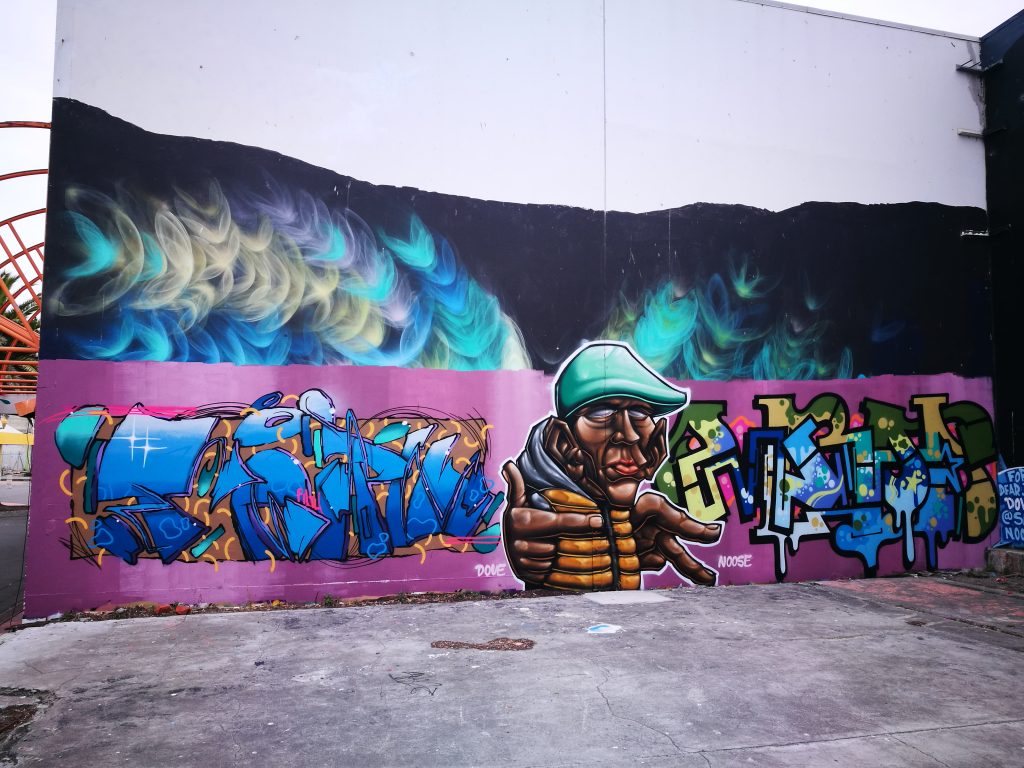
Technology is making that transition easier though, at least in some respects, right? I was recently watching a video of someone using a Posca pen with a Crayola add-on airbrush piece, to create the effect of a tiny spray can painting a stencil. Obviously, there are problematic elements to the embrace of technology, but it must at least make some of that transition easier…
I think with some of the programmes they have on iPad’s and that sort of thing now, it is crazy the different ways you can digitally replicate how you would paint on a wall. It is not something I’ve had a chance to muck around with a lot, but in some of the work I’ve done with Dove especially, he’s used that technology to map out how something would sit on a wall, and that just makes a crazy difference when it comes to actually visualising a large-scale project…
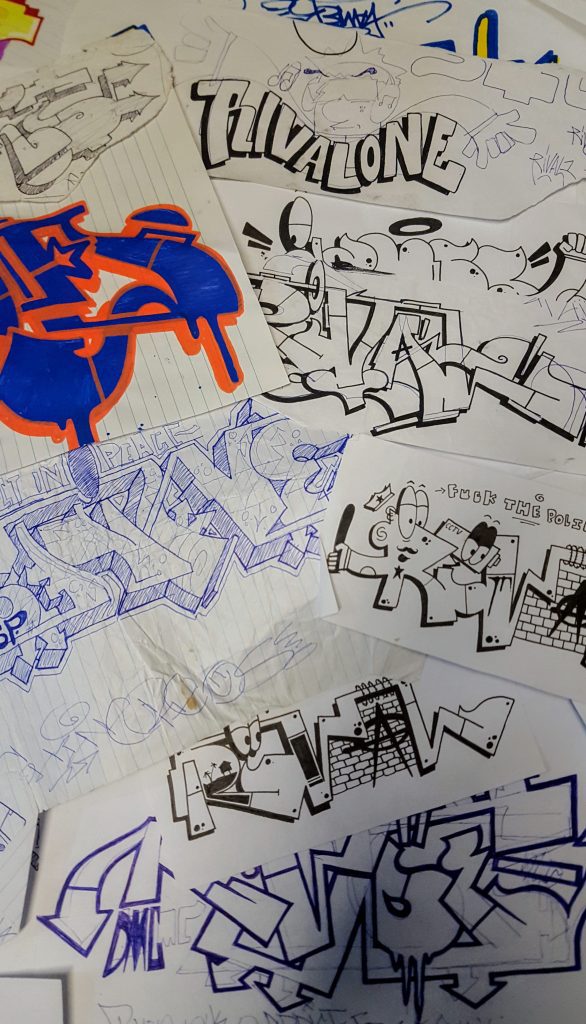
Do you have a process to scale up from a sketch to a wall? Often artists have a specific approach that is slightly different depending on the individual…
For me, it’s the same with everything; graffiti, murals, I just start by taking steps. I step out the length of the wall. Say it is twenty steps and then for example, if it’s piecing, and you’ve got four people, sweet, you’ve each got five steps, and I just mark it out and work from there…
Even that simple approach, it essentially represents one of graffiti’s core attributes: the ability to solve problems. There’s always been that DIY nature, where you can do more with less by problem solving. You are constantly having to overcome problems when you are painting graffiti or making art in the streets in that manner, and that’s why I guess that transition to large-scale work is so achievable, because of the skillsets you pick up painting without permission, or painting without the support mechanisms of a studio space, or a commission…
In terms of proportions, even with my graffiti, my work is quite mathematical. I guess it ruins some of the natural flow when you explain it, but I’m literally looking at the first line I did on the wall and following it from there. I’ve got maths going in my head, like, that width between each line is twenty centimetres, so I should make it about that the whole way through. I’m stepping back and judging widths of the letters themselves and the space between them along with the thickness of each individual line itself. So, I’m actually thinking about how certain attributes that come later will affect the piece as well, especially adding shadows, it’s something a lot of people seem to struggle with, but there’s almost a mathematical formula to how a piece sits on the wall. I also use shadow to help add dimension to my pieces rather than one flat image sitting on a wall, so it is a series of intertwined connections overlapping and underlapping each other.
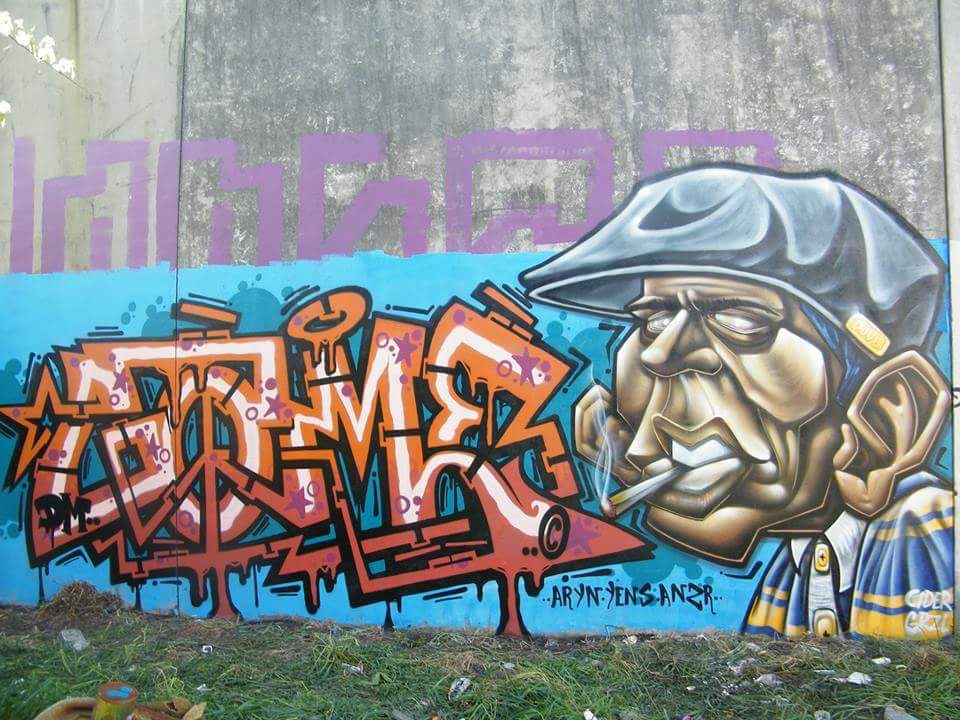
With drop shadows and those types of effects, it is literally mathematical, right? It is about the angle created by the light source, the angle you are trying to project and those types of things. It’s also something where you can fall onto either side, though, right? You can be looser, more chance driven, and all about how it looks and feels, or you can be more precise and adhere to spatial relationships and certain effects that you are trying to achieve. Your graffiti letter style is kind of angular and quite strong in its line work, do you that comes out through that kind of mathematical approach?
Like you said, you can go either of two ways with it. I’ve probably wished I was more comfortable doing a more natural approach, but like I was saying earlier, my pieces are very controlled. To add even more mathematics and numbers, I’m also always trying to add my work into a certain slot of where I feel comfortable. Like, I want to do pieces at the moment, I need to do everything in my head that justifies it being a piece, to then fit into that slot where I can be like: ‘O.K., now I’ve done forty-seven pieces.’ If it’s missing certain elements to it, then I can’t class it as a piece.
So, there’s a classification process going on in how you are building your body of work?
Yeah, so, it’s something that I’m almost forcefully trying to do. I’m sort of restricting myself. I’m not going out as much and doing more creative stuff, stuff off the top of my head, because in my mind, that would fit into a different slot. Which is perfectly fine, it’s just my sense of control makes want to be able to categorise what I am doing…
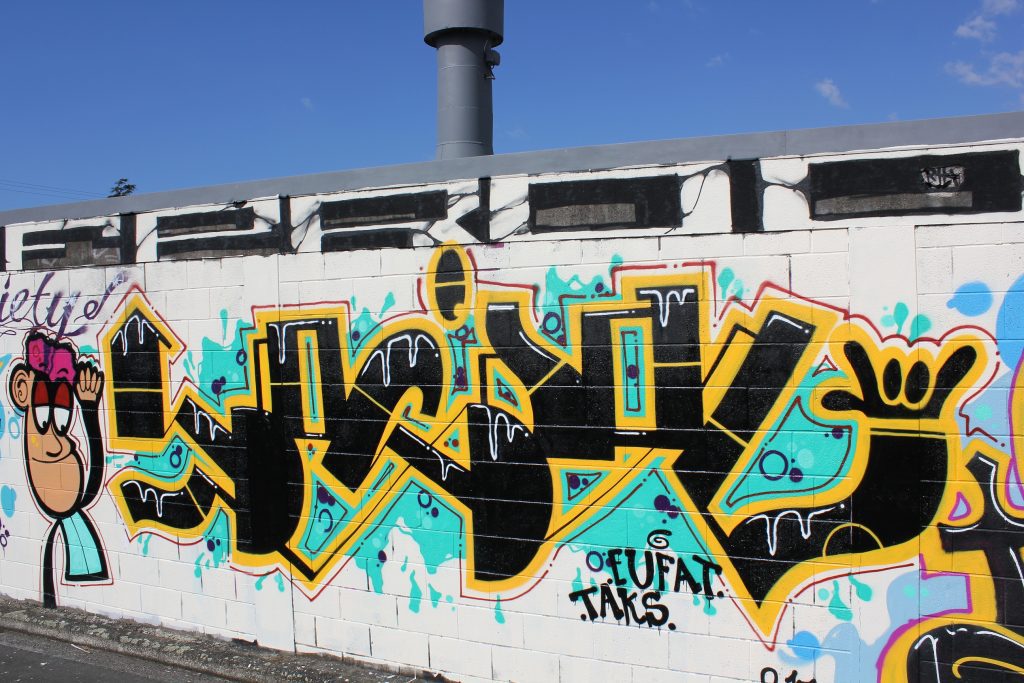
Is there an end goal in mind then when you are taking that approach?
Like you were saying, it is just building a body of work. Not so much to show other people, it’s more just self-confidence, knowing that I have got that body of work behind me. That will allow me to feel more comfortable going out and doing weirder, less-appropriate sort of things…
Does it give you a good sense of how far you have progressed already? Does it become obvious to you?
Yeah, with my letters at the moment, I do make some dramatic changes, but generally speaking, each piece I paint, I’m trying to develop one letter. So, there are four letters in the name I write, right now I’m working on developing the ‘O’, so if you look back at previous works, the other letters will be the same, but the ‘O’ will be different. The next piece, I might decide I’m happy with the ‘O’, so I will start developing the ‘D’, so then, like everything, you will actually see the natural progression of how it’s changing. Right now, I’m actually reverting back to a lot of my earlier work from the beginning of last year, stylistically, because I feel like I drifted off in the wrong direction and now I’m going back to that body of work and seeing where I was going with that. That’s why having that control of doing a piece is important I guess, I can see where I was going wrong, or what I need to do instead. Even with that amount of control, you still make mistakes. I’m not particularly happy with my style at the moment, I think it has sort of regressed a bit over the last few months and that’s why I’m looking at the older work and hopefully bringing it back…
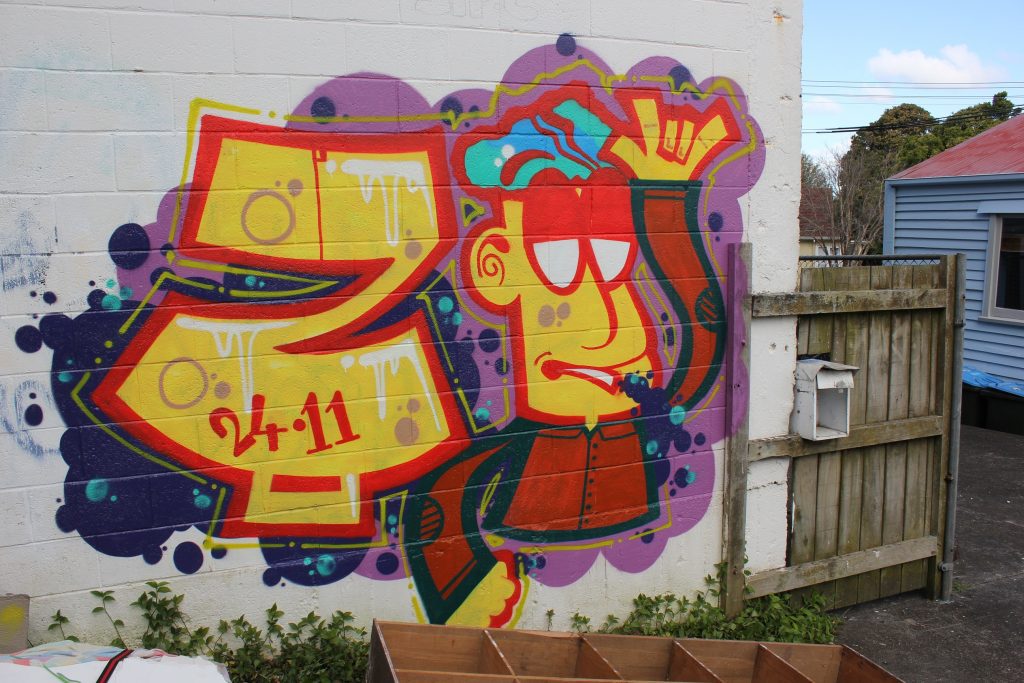
That’s a really mature, thoughtful approach. Was that compulsive element, repeating a tag or developing letters over time, was that always one of the attractions of graffiti for you? And how do you relate that sort of approach to commissioned projects? Do they require a slightly different approach?
You could definitely say I am a bit obsessive compulsive and that definitely is evident in the way I paint. With the commissioned work, I think as long as you get the O.K., I’m a lot more open to switching things up. The pump track mural, I did control that a lot as well, specifically to ensure it had that more comic effect, with very bold colours. There were a lot of parts, especially the birds, where I would have liked to have thrown in more detail, but it would have taken away from the rest of the mural. Although I knew there was more that I could add, I had to control myself and let it be what it was. But now, after doing that, I’m definitely a lot more confident in being able to wing it a bit more, to chuck my own flavour in there. There are definitely challenges that come with painting concepts and ideas that I have never really attempted on paper, let alone a wall.
Commissioned work also generally allows more longevity. You can often physically revisit a work over a longer period. Does that affect your thinking as well? Which reminds me; we were just told that your mural will stay in place for longer than originally thought as well, the project has just been extended, which is good news! So, what is that shifting mindset like between a work that might only be there for a day and then disappear, and a work that is somewhat more protected? For someone who is so analytical and thoughtful, is it tricky constantly being reminded of a work, thinking I could’ve done this, I could’ve done that…
Yeah, absolutely, especially with that mural, because I was working between a lot of other commitments. There were a lot of hurdles I had to get over, so it ended up taking a month and half of on and off days. So, yeah there were a lot of sleepless nights thinking about something I really wanted to do before I forgot about it. I was borrowing my friend’s ladder, and near the end I just got him to pick it up so I couldn’t really do anymore work without having to organise more stuff. It was almost a case of someone having to just take the can out of my hand and be like, that’s enough, it’s’ done.
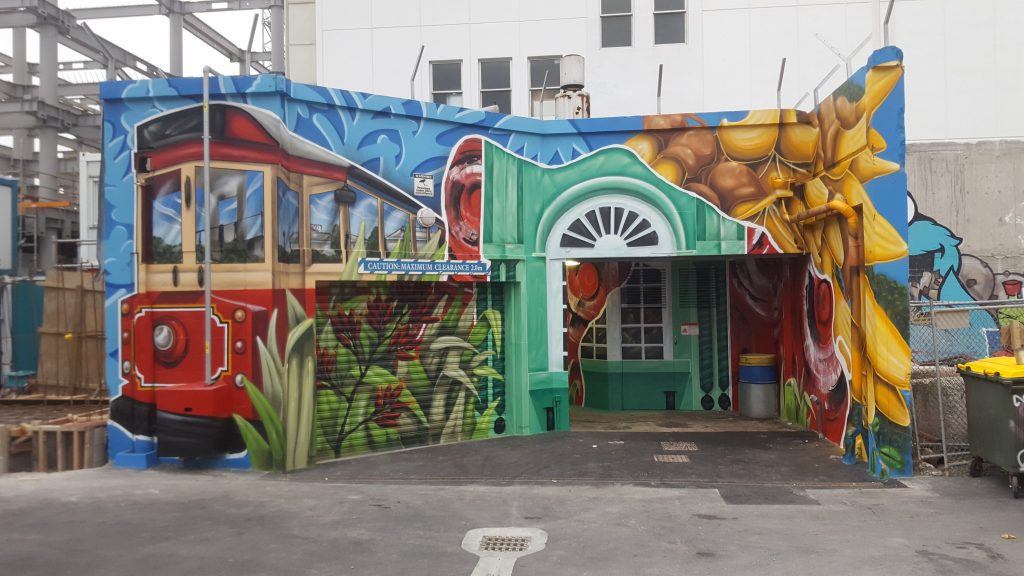
I guess when you are having a jam, generally you are looking to finish within a shorter time frame, although there are other reasons you might finish when you finish, but with the longer time afforded a commissioned work, it is probably good to have some limit imposed on you…
Yeah, well, graffiti is incredibly speed-based, especially in New Zealand. It is almost frowned upon to spend any longer than a day on a piece, although, in my opinion, if your piece needs three days of work, then put three days in, make it the best possible.
Some of that comes down to the spot though, right?
It’s definitely tossing it up a little bit. But yeah, with my pieces, especially doing the fill and the initial outline, I am sweating trying to just get it done, to get the piece up on the wall. Then I will spend the same amount of time just tidying it up, stepping back and looking at it. My main goal is to try and finish it before everyone else, so I’ve got that five or ten-minute window of being able to step back and look at it. I took a similar approach to the mural as well, but with no experience or any time frame to go off it was really hard for me to tell what speed I was meant to go.
You mention the New Zealand scene as a whole, you are based here now because you are studying here in Christchurch, but you are from Auckland, right?
Yeah, born and raised.
So, growing up in Auckland, what influences were the strongest impact on you growing up? What got you involved? Auckland is so different from Christchurch, what were the biggest things you noticed coming down here?
Well, since coming down here, I’ve always looked at Christchurch as almost being in a time warp, almost ten or fifteen years behind. Not as far as skill goes, there’s some amazing artists down here, but the train tracks down here now look like how Auckland looked in the early 2000s, and that was the era that got me into graffiti, so I love the scene down here, it’s what we’ve now lost in Auckland because of the buff…

It’s almost nostalgic for you… (laughs)
Yeah, and the creative energy, with so many blank walls, like in Auckland, every spot has been done to such a high level, that it is almost like: what’s the point? It’s already been ‘kinged’, someone’s already done something better, whether it’s a stomper, a tag, a piece, it’s already been done. Down here, even along the train tracks, you’ve got walls that have literally never been touched. Whatever you do on it, it’s going to be the best thing that’s ever been done on that wall…
There are two ways to look at both of those things as well, like you say, if somebody has already done something amazing, it’s either what’s the point, or there is a real drive to try and better it, or, when the are no precedents, you’ve got the freedom to do something without expectations, or you can get lazy and the level gets pulled down…
I guess from my point of view, being a bit older, I can really see opportunity down here. When I was younger in Auckland, I didn’t appreciate how lucky I was to be a part of that scene at that time, even in the early 2000s, I remember thinking, I wish I grew up in the 90s! Then when the buff hit in 2011 (when the Rugby World Cup was staged in New Zealand), it was like, oh crap, we were painting in the golden era of Auckland graffiti and we took it for granted! We should’ve been out doing pieces on all these spots instead of tags! But down here, it’s different for me, with that maturity that comes with age, and a desire to just do pieces, just being able to have that confidence in my style, I can quite confidently make a wall look better than it was…
Which again is a mature attitude, it is not what every writer is trying to do…
I do contradict myself quite a lot, and I still feel a lot of the different moods of graffiti. I think it’s important though, it can be very restrictive sticking to one set of views. But, generally speaking I like to paint for the act that I am making the wall look better than it was. It might not be publicly appreciated, or aesthetically pleasing to everyone, it’s still graffiti, but its better than the tagging that was on the wall before. This is also my general argument or, I guess, defence if I was to be approached by the public.
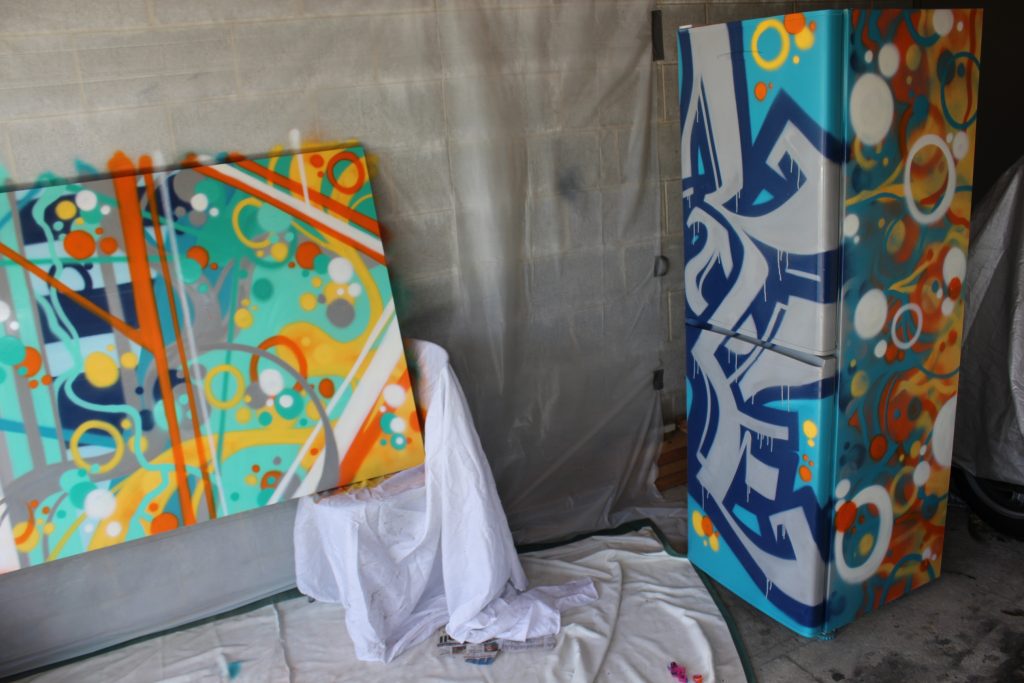
For most people, it is the legal issue, the private property issue that is the most upsetting, and that is what leads them to say they don’t think graffiti is aesthetically pleasing, and that is sort highlighted by the way a buffed wall, with patches of mismatched paint, is clearly not an aesthetic improvement…
I find that very ironic, there are some very bad clean up jobs around that look worse than the tagging itself did. A particular example of this for me is when people tag using their fingers on a dirty wall or window, obviously it is still vandalism, but it is simply moving dirt around on a neglected surface that no one has taken the time to maintain. I would argue the wall was not aesthetically pleasing to begin with and the tagger simply pointed that out. With that said, I do hear the argument, even from writers, that they would be pissed off if their fence got tagged. But for me, I’m a pretty placid human being, if someone did paint my fence, I would go and paint it out and get on with my day, it’s not something that really stresses me out…
A fence is an object that defines territory, and as such it invites responses in some way, right? I’m not saying a fence deserves graffiti, but it does say: ‘this is my space, keep out!’ So, both because of that symbolic presence, as well as the physical form, something is likely to end up on them… it’s almost inevitable, even if it is not necessarily pleasing.
It comes back to that core emotion that people look for from graffiti, why people paint, we’re looking for that mental reaction. nothing beats being in the city at two or three in the morning, with no one else around, you’re walking down the middle of the street, and whatever you want to write on, whatever you want to climb, no one is stopping you, the city is yours, you own it…
[American graffiti historian] Roger Gastman has written that at its core, graffiti is about young people exploring the city, and as you say finding that freedom, those boundaries seem to vanish. On the flip side of that, how did you make the decision to take on commissioned opportunities? Were you influenced by what other people were doing? Did it germinate in Auckland, or was it more a case of the opportunities in post-quake Christchurch? Was it something you always thought you might do, or was it something you came around to?
Like I was saying before, I contradict myself a lot. I go between wanting to be a reclusive vandal and wanting to screw society up, to wanting to make society better, make it more beautiful, be a part of the wider community, go to events, talk with people. In Auckland, I guess, I got into the concept of tagging, not that I ever thought I would do it, but my older sister, who is in her late thirties now, a lot of her friends were ‘gangsta’ taggers, they don’t tag anymore, they have all moved on to actual serious crime, a lot of them are in jail now. But I was opened to that at a young age, and a lot of them were amazing graffiti artists, classic old school wildstyle painters. I can remember being eight years old, and trying to copy a drawing I had found, and I was just drawing heaps of arrows, and being like, how do you do this? That lasted maybe a couple of days, then you move on to the next little game or whatever. But then I revisited it as a teenager. One night I was staying at my mate’s place, and he was like alright, we’re going tagging. I was like, what’s that? I thought only people from the hood did that? Which is a racist view, really, that only poor neglected kids go out tagging. Why would a proper citizen, from a private school, who has the opportunity to be successful, start tagging? But ever since then, I caught the bug for it.
That’s what they have said about New York, that because hip hop was very Afrocentric, everyone assumed graffiti was the same, primarily the realm of poor black and Hispanic kids. But the reality was that graffiti was broader, it wasn’t as defined by your position in society as some of the other elements of hip hop…
It’s kind of funny, when you get more involved in the world, people still have that view, that it’s brown hood rats out tagging, when its just as likely to be middle-aged men with full-time jobs and families. Some of the most prolific taggers I knew in Auckland as kids are looking at owning their own home, or already own it, dealing with full-time job, a lot of them are sober of everything and they are still out every second night painting. I remember seeing an article years ago about Deus from Auckland, and the article was so racist, the actual headline was like: ‘Taggers are not just brown, poor and from South Auckland’, or something like that, and then it had a picture of Deus, an older white guy with missing teeth, quite an eccentric guy, dressed like he’s a bit homeless, and he’s one of New Zealand’s best artists, the complete opposite of the stereotype of what people think of graffiti, and he is at the pinnacle, especially of character work in New Zealand…
What are your next goals? You have talked about this cataloguing approach to pieces, and this increasing commissioned work, is that just a case of balancing the two, or does one become a focus?
I think that the commissioned work motivates me to do other things, because I don’t want to be known as a muralist. I enjoy painting murals, but as soon as I allow myself to be known as a muralist, or a ‘street artist’, that’s what really opens up my work to getting destroyed by younger taggers. So, there’s that certain aspect of keeping up my rep, whatever rep or street presence that may be. I’d like to let people know it’s cool, if you want to do it, take the opportunity if you can…
Some people decide it’s one or the other and go for it whole-heartedly, so actually deciding to do both and how you go about contending with both worlds is quite challenging…
I was having a discussion with Juse from Wellington, and we were saying it takes maybe like ten or fifteen years into your career before you can really know your work, which to some people sounds like a hell of a long time, but in art and graffiti, it’s really just the tip of the iceberg. If you look at people like Askew, he has been doing it since the early nineties, but its only just in the last like five years you can see that he has really found his purpose and found comfort in doing what he wants to do, and that’s more than twenty years of work that’s got him to that point…
The penny doesn’t necessarily drop quickly, right?
Yeah, like I remember starting out and being like, I’ve done graffiti for like two years, I’ll be good soon! My first piece was around the beginning of 2006, so I’ve been doing it for over ten years…
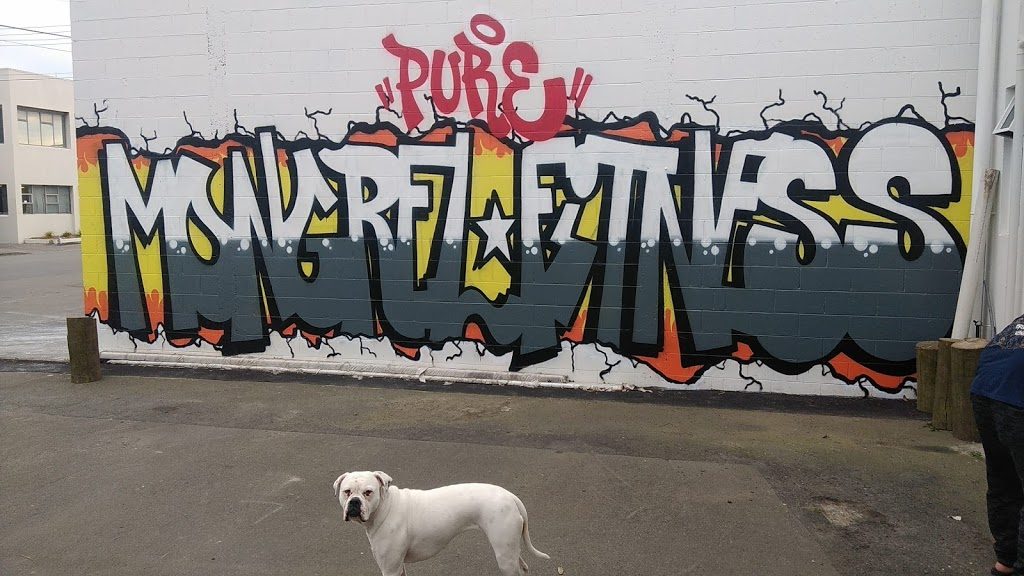
It’s a constant journey of self-discovery, right? You admitted earlier how there are always elements of your work you are unhappy with, and that is kind of what makes it such a long journey. It’s about your own standards, developing ideas, there is no end goal…
It’s bloody hard, you know? For anyone thinking of taking this up, it’s a big commitment, and you are never going to be satisfied. There’s always another spot, another piece, a different colour scheme, there’s always something. There are so many people in this scene, even since I got into graf, the scene is crazy big, and every country has a heap of cities and every city has suburbs. There are some amazing artists from all walks of life doing it, constantly pushing boundaries. I don’t think anyone could have imagined where graffiti would go…
It’s crazy, when you think about the roots in Philadelphia and New York, and now everywhere has its own scenes and micro-scenes; the hip hop tradition, punk, skateboarding, trash, anti-style, and then within all of those, you’ve got people doing different things, and with so many people…
It’s like all art, everything is influenced by your surroundings. We have the internet now, there’s obviously a lot of hate for it, in some ways it’s not as natural, but at the end of the day, it has just opened the doors of where you can take influence from, we’re no longer taking influence from our scene or street, we’re seeing every single suburb in the whole world…
The key thing is that if you are taking influence from somewhere, you need to know why something looks the way it does. If there is a cultural influence, there is a responsibility to understand that influence, and you also need to understand the relationship to space and place of where you are, and how it relates to what you want to do. There are a lot of things to acknowledge…
That’s exactly right, New Zealand has a great example of that; the tagging style ‘straights’, which is actually a very, very refined, rigid typography which takes a lot of discipline. It developed in the early nineties, from an old FDKNS member’s trip to Los Angeles I believe, and he came back with a lot of photographs and that developed this style and it’s since become a completely unique New Zealand style. Like you said, without understanding it, you could copy it and it would look like straights, but it’s not straights, it hasn’t got that discipline, and you need to understand why the letters look like that. Even now in Auckland, there is a West Auckland style of straights, an East Auckland style of straights, and you can’t just mix the two together, which I noticed in Wellington or Christchurch, where people just kind of copy the idea of straights, and there’s something missing from it or added to it. It makes it unique I guess, like Christchurch has its own form of straights, Wellington does too…
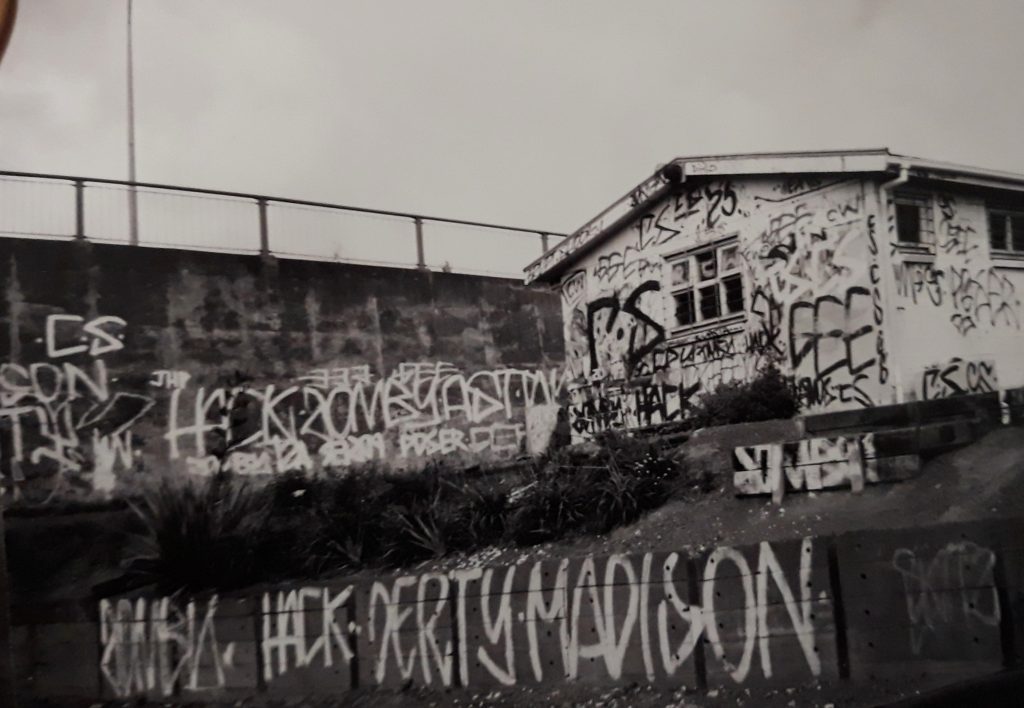
But they are not strictly the form that developed in Auckland, which brings its own specific influences…
Even just growing up in Auckland, if you showed me a set of straights, I’d be able to tell you what era it was done, because every year it is changing, or there was a particular style or letter that was pushed, and that was another thing, I guess, biting, copying was sort of expected with straights, if you were pushing it, you were expected to know what went before…
Perfecting it rather than pushing it because it is a specific visual language you are aiming to replicate. Shifting focus, tell me more about your field of study, because there is an interesting connection…
I’m doing a Batchelor of Criminal Justice, which is a Criminology degree essentially…
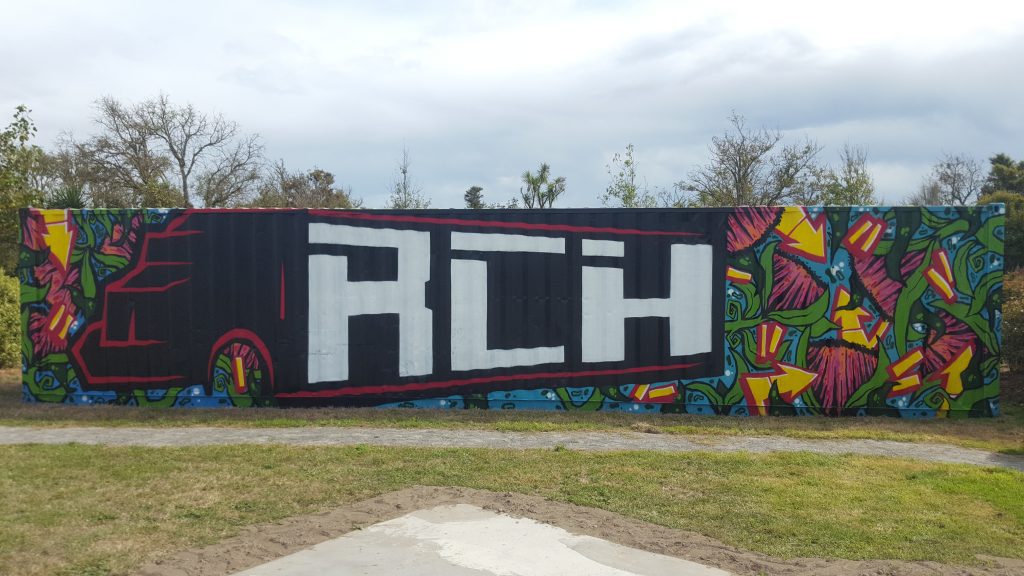
Did your graffiti writing background influence your decision to go in that direction?
Yeah, not so much in the sense of actually writing graffiti, but the consequences of it. I’m not embarrassed to say I do have a criminal record, I’m very strong in my morals, if I think it is right, I’ll do it, even though it might be against the law. I think I’m pushing eight or nine times just on wilful damage charges. Just dealing with the court system, I’ve seen a lot of people who have been abused by the system, just because they have a lack of knowledge of how to deal with it. I’ve been lied to, I’ve been taken up the garden path, and told we won’t charge you, and then you admit to something and it’s like sweet, you’re under arrest. I don’t know about other countries, but in New Zealand they don’t teach your rights enough in school. I think every school should have some class about knowing your rights, because Police and anyone with authority can abuse their power…
I’ve always believed that any education programme should have some moral or ethical philosophy component. If we had more people who understood, not only their rights and how the justice system works, but who also have the ability to make up their mind about what is morally and ethically right, it would go a long way. So, when you finish, will you try and connect those worlds?
Obviously, I do have issues with a criminal record, which does impact where I can go for now, it will take time, but I will get where I want to go. I definitely want to end up doing some sort of social work. I’m already putting myself out there as someone willing to talk to people. I’ve gone to a lot of my friends’ court cases as support, because it’s a scary, intimidating thing going to court, even if it is just for drinking in public and its just a $200 fine, it’s still really intimidating. So, just having someone there, telling you it’s all good, that the worst that can happen is you might get home detention. They are thinking they might go to jail for two years, so it’s important to have someone who can say it is alright, don’t stress out and be confident with what you are doing. I’ve always found the worst punishment is not knowing, once you get charged, you got a couple of hundred hours of community service, O.K., I will knock that out, and move on. But that few months of: Am I going to get charged? Could I go to jail? Just getting stuck in the system is an incredibly scary thing…
Thanks man, it’s been really interesting, I look forward to seeing what comes next for you… Do you have any shout outs?
Yeah, shout out to Watch This Space obviously and Gap filler, also my boy Dove, the FOK and AOC crews and anyone in Christchurch that is doing their thing at the moment. And thanks to Cent for documenting the scene and helping out with some photos!

